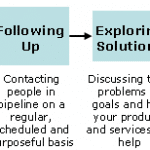What does your fitness or wellness business do? If your answer is something like “women’s fitness”, “nutritional counseling services”, “yoga”, or “personal training”, then the immediate questions are: for whom? Why? What’s so special about YOU? Why would they pick you over someone else? Maybe the truth is, you don’t know what you’re selling. A lot of the folks who come to us don’t. They just know what they have, and that’s not the same.
The trick to fixing this problem is in finding out how your best customers see you and why they keep coming back.
What Customers See in You
You cannot answer this question by simply stating what you have. What you may have is:
- A presence in most major cities in the US
- Typically, a 3000 sq. ft. facility with a lot of punching bags
- Mostly women customers
- Mostly suburban locations
That’s what Title Boxing Club has, but it isn’t what makes them special. Customers go there because it’s a clean, bright, safe place for folks to get in some serious cardio, tone up, learn self-defense, and build self-confidence and fitness without venturing into the inner city and actually getting into a knife fight.
If you’ve got even one customer already, ask yourself why they’re a customer. If you’re not sure, ask them to tell you — don’t guess. I promise you it isn’t your room full of punching bags or your certified dietitians.
Now, start with what your customer(s) told you, and look at every piece of your marketing copy and ask if it moves that conversation along. If it’s just a list of your supplements or equipment or the names of your trainers — and nobody knows why that matters, consider ditching your sales and marketing literature (including website copy) and starting over.
You’re Not Selling Your Equipment
When was the last time somebody called, emailed, or walked into your club and asked, “Do you use Landice Cardio or Woodway treadmills?” Or “What brand of spin cycles do you use?”
People care about the experience. The good thing about this is that your wellness business is probably uniquely influenced by your perspective and personal experiences with fitness and wellness. You have a story. Each of your customers has a story. The sum of those stories is what makes your business special.
Even clubs on shoestring budgets, with thoroughly used, rough-looking equipment can create a special brand based on what’s unique about them. Even the gritty, no-nonsense, slightly-run-down “Fight Club” feel of downtown gyms can be appealing. Until real estate developers forced them out of their downtown location after decades of being in business, Dallas gym Doug’s Gym built a name for itself as the kind of place you’d expect to see Rocky working out when he wasn’t sparring. But the fact that it wasn’t “pretty” was part of the hard-core appeal.
The thing about Doug’s Gym in Dallas was: they were all about building strength and muscle, no excuses, all sweat, and no pretty folded towels in the locker room. They crafted that image, and the associated messages, over the years, and never did ANYthing to undermine it. If you want blow dryers and a big screen TV, join a country club.
That’s not to say you shouldn’t keep your equipment in working order, and trust me, when it’s actually something other than free weights or body weight workouts, Doug’s did. Contrast that with one gym I visited in Silicon Valley, a similarly run-down-looking facility with competitive rates, set up in the town’s old Supreme Court building. Last time I visited, equipment was jammed together so closely it was probably a fire hazard, and much of it wasn’t working. That’s not “gritty”, it’s just a lack of attention to detail.
Separating Features from Benefits
There’s no problem in telling folks you have a Cardio Theater, as Gold’s Gym does. They make no mistake in letting you know what movie is showing on what day. If you want to see the latest Marvel flick, you know what night to go, and when.
But the benefit is clear: I go to the gym, and I get to see a movie that’s not on Netflix yet, which I don’t have to rent. It’s the theater experience that’s the benefit. That’s why you’ll notice the video equipment is working even when one of the treadmills isn’t.
One of the benefits of Planet Fitness — and a key part of their marketing message — is that it’s not a place for “lunks”, their word for the kind of musclebound, grunting strongman who drops 100-pound weights on the ground when he’s done with his reps. They actually encourage customers to ring a bell when they see this happening, to discourage if not outright embarrass such patrons. It works.
Planet Fitness’s “feature”? It’s a bell, hanging on the wall. It’s not a piece of workout equipment at all. The benefit? PF is an ordinary-Joe, ordinary-Jane kind of place where you can just go do your workout quietly and leave. If you’re a troublemaker, you’re not welcome, and that makes it feel like a place anyone could go.
Honoring Your Message
The one question we most often ask of our clients is: who are you — really? It sometimes takes a few sessions and a bit of soul searching for them to decide, and it’s a question only THEY can answer.
Once our clients have that answer, it’s amazing how clear things become in their minds, and how quickly some vexing decisions make themselves.
If your club is about teaching women self-defense and confidence, then don’t spend time on your website making them feel nervous about their bodies or worried about their nutritional regimen. If your business is training elite Ironman competitors and wannabes, then don’t bother with the couch-potato-to-5K program.
Picking a message and sticking to it helps prioritize key business objectives, and makes it easier to fight “bright, shiny object” syndrome (a condition in which businesses are attracted to whatever is new, faddish, or otherwise not-what-they-do-for-a-living).
If you’re all about personal trainers who listen and adapt training to your customers, then stick to that. Don’t get off on tangents about Fresh Fruit Friday or your favorite immune system booster.
Now that you know what’s important, the next step is to make sure it ties back to customers.
Tying Your Message Back to Customers
Once you establish your wellness business’s core message, four possibilities exist:
- It resonates with a particular type of customer you want, that you can then target more carefully
- It resonates with a particular type of customer, but there are too few of them to sustain your business’s cash flow
- It resonates with a particular type of customer, but not the one you want — if this is the case, you need to adapt your message to the customers you DO want, or adapt your business to the customers you are attracting
- It doesn’t appear to resonate with anyone in particular — in which case you may want to consider altering your message or target customer
Often, this is where we get blank stares from potential clients. They don’t WANT to change who they are. They want customers to love them without needing them to change.
Sometimes that works. Sometimes all it takes is to help a client realize that while they thought their business was about being a nutritionist, they’re actually an inspiring example of take-charge leadership and life-change for Hispanic women.
Ultimately, it’s financially more sustainable to identify an unserved or underserved market first, quantify the opportunity in terms of potential customers and revenue, and develop a business model around those customers and prospects. If, however, like many wellness entrepreneurs, you find yourself “riding your passion” in search of prospects, the most critical step is to identify and locate reachable customers who will probably find your message appealing.
With a little help, they’re just around the corner.




